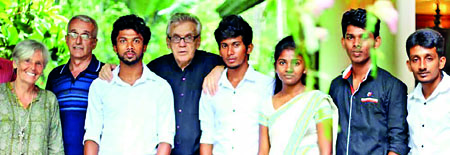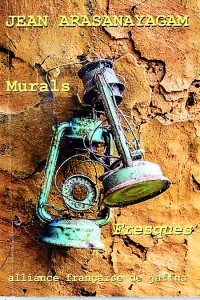Words, art and photography unite and flow freely

The artistes with the editor Gerard Robuchon and Jaques Soulie of Suriyakantha
This compact little bilingual, French / English book of writing and photography, Murals Fresque, has a paradoxical element; although small in size, it represents the convergence of so many strands of words, media,art and language. In spite of these collaged features, it is neither awkward nor fragmented; in fact, its content flows as so many rivers do, out into a mutual sea of empathy. The book shows an untainted form of association with a group of protagonists, each free to create!
On these pages we can feel the easy collaboration of diverse talents which bring together inspiration from geographically disparate areas of this island and beyond. The four talented artists and photographers, all born in 1993, are students of art and design at the Department of Fine Arts, Jaffna University: Susiman Rinoshan, and Ramanathan Parilojithan are from Batticaloa, Selvarasa Thivakar is from Trincomalee and Sundararajan Thulanjani Nirosha from Kandy. Their collaboration and friendship is infused with enthusiasm, the lack of cynicism of the young and travels beyond obstacles and narrow ideals for the sake of art. 
The four present, beautifully crafted telling, innovative, images of the day-to-day in the dry hot peninsula, their temporary home. Their art-photography shows a maturity beyond their years and worldliness; a love, a curiosity towards young and old alike, portraits of women, battered yet bejewelled, a fascination with familiar objects in their banal yet vital diversity. Objects and people are intermingled, environmental ‚Äėsustain life‚Äô‚Äô washing lines, bicycles and lights, corrugated iron, meet with beautiful stillness, dark and light, night and day, faces, snapped with respect, tattered by time and life, broken and sad, fiery and optimistic. The 30 images are bursting with a human resilience and the backdrop is often of familiar pastel, pigmented, dilapidated walls, half refuge and half temporary shelter.
Then there’s the writing which begins with a prologue by Manuka Wijesinghe, her fitting introduction carries brave universal words, still vital to say and believe:
‚Äúwhen a father builds a house, it is the sound of children that should fill its space, not the wail of death‚ÄĚ.
‚Äú‚Ķ.remember when war ends, living begins‚ÄĚ.
And in homage to the book, “its writers, photographers and mentors are not only its objects but its subjects. This is a book about life that goes on living’’.
But the core, the central text which cohabits with and is faithful to these photographic images is by the great writer and poet Jean Arasanayagam, whose words, as always are bold and compassionate. The poet’s awe-inspiring English is traversed by pure art, magical, mythical images so full of “chiaroscuric hues’’ colour in sadness, gems in the faces of the poor. The free stream of consciousness writing at its best is paradoxically mindful and structures itself to encourage the contemplation of the images, to examine them further, read into them, and find our own honesty.
The poet observes this world, first her self: “my stanzas are the votive offerings I proffer lavishly culled from my mind.’’
Then further into the perilous environs: “doorless habitations painted with the tempera of pigmented shades with their mutations created by time, neglect, wars, abandonment…………masterpieces in the endless open air galleries…..’’
Then the people, women “ …reflecting travail possess an immutable beauty left by the patina of age, of mute suffering of poverty…deprivation.’’
And further to other artists: “Rembrandt, Vermeer, Da Vinci, Botticelli brought to our minds in the living portraits that we encounter in our times and in our age’’.
Arasanayagam’s stanzas are devotedly translated into French by Gerard Robuchon, the language offering access to an even wider readership and giving the opportunity to decipher, understand words from other worlds. Robuchon, director of the Alliance Francaise de Jaffna is the editor and catalyst of this book where participants agreed with unanimous commonality to create together and we can feel this unhesitating sharing and acceptance; the editor succeeds admirably in pulling people together in kinship.
The book launch and exhibition of photography took place on March 8, and the exhibition of photography will continue through this June at Suriyakantha Centre for Art and Culture, at Naranwala, Handessa (10 kilometres from Kandy) in this atmospheric ‚Äėmusehome‚Äô where a visit is a feast for the senses. 081 231 55 45 (Info@suriyakantha.org)
The book can be purchased at Suriyakantha or by contacting the Alliance Francaise de Jaffna , 61 Kacheri-Nallur Road Jaffna 021- 222 80 93 (alliancejaffna@gmail.com)    So if you are travelling through the hills or up to Jaffna, pay a visit, find the book and carry it with you on your travels through the island.


